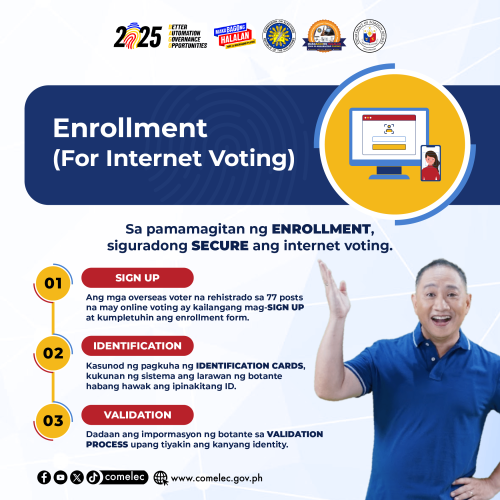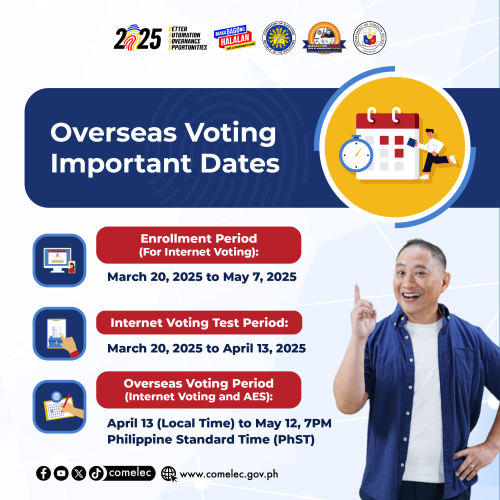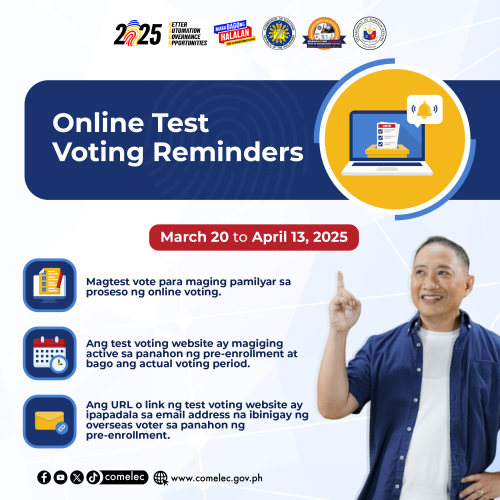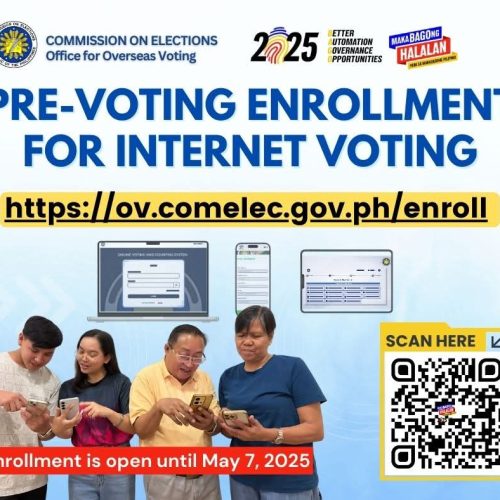OVERSEAS VOTING
PUBLIC ADVISORIES, MEDIA AND INFORMATION ON OVERSEAS VOTING REGISTRATION





COMELEC’s Media Page on the Online Voting and Counting System.
Need Help Pre-Enrolling for Online Voting?
Call the Online Helpdesk via Google Meet, open daily from May 7 to 11, 9:00 AM–5:00 PM (PDT)
https://tinyurl.com/pcgsfovs2025
2025 NLE OVERSEAS VOTERS LISTS
- CERTIFIED LIST OF OVERSEAS VOTERS (CLOV)
- CERTIFIED LIST OF OVERSEAS VOTERS FOR SEAFARERS
- NATIONAL REGISTRY OF OVERSEAS VOTERS (NROV)
FREQUENTLY ASKED QUESTIONS (FAQs) FOR OVERSEAS VOTING REGISTRATION
Answer:
That depends if you previously voted as an overseas voter. If you voted in the 2019 and/or 2022 National Elections, then your registration is still valid and active.
However, if you failed to vote in the last two consecutive elections (2019 and 2022 elections), then the Commission on Elections (COMELEC) in the Philippines would have deactivated your registration record.
You may send an email to [email protected] to check the status of your registration.
If you changed your home address since the last elections, you must also register again to reflect your new address.
Answer:
The overseas voting period for the 2025 Philippine National Elections will start on 13 April 2025 until 12 May 2025.
Elections in the Philippines will be on 12 May 2025.
Answer:
For the 2025 National Election, registered voters will be able to vote for 12 Senators and one Party-list Representative.
Overseas voting is the process by which qualified citizens of the Philippines abroad exercise their right to vote.
Who can participate in Overseas Voting? All citizens of the Philippines abroad, who are not otherwise disqualified by law, at least eighteen (18) years of age on the day of elections and must be an active registered overseas voter.
How can I check if I am an active voter? You may check your voter registration status at https://comelec.gov.ph/?r=OverseasVoting/2025_NROV_CLOV or https://pcgsanfrancisco.org/wp-content/uploads/2025/01/clov1.pdf
It is a secure system of casting votes online. Votes are cast through a secured online platform instead of on paper ballots and can be done in the comfort of the voters’ own homes or workplace. Overseas voters (OVs) need not go to the Embassies / Consulates to cast their vote and only need a computer or mobile device (phone or tablet) with Internet access.
Since there is already an Online Voting portal, no ballots will be mailed.
Registered overseas voters must complete pre-voting enrollment to verify their identity and registration status. This can be done online or at designated voting kiosks.
- Enrollment Deadline: The pre-voting enrollment period ends on May 7, 2025, at 23:59 PM Philippine Standard Time (PST).
- Voting Period: The actual overseas voting period is from April 13, 2025, to May 12, 2025, ending at 7:00 PM PST (4:00 AM San Francisco Time).
- Eligibility: All Filipino citizens abroad, at least 18 years old, and active registered overseas voters can participate.
- Voting Process: Voters will receive credentials to access the online voting platform after successful enrollment. They can cast their votes using any internet-capable device. Note that there will be no mailed ballots this year.
- Security Measures: The online voting system includes multi-factor authentication, encryption, and an audit trail to ensure voter privacy and the integrity of the voting process.
- Assistance: Voters with special needs, such as senior citizens and people with no appropriate devices can receive assistance at the voting kiosks.
Important Dates:
- Pre-Voting Enrollment Deadline: May 7, 2025, at 23:59 PM PST.
- Voting Period: April 13, 2025, to May 12, 2025, ending at 7:00 PM PST (4:00 AM San Francisco Time).
Official Links:
- Pre-enrollment: https://ov.comelec.gov.ph/enroll
- Voting portal: https://ov.comelec.gov.ph/vote
Voters can check their registration status at COMELEC’s website. The voting kiosk at the Philippine Consulate in San Francisco will be available from April 13 to May 11, 2025, from 9:00 AM to 5:00 PM. For further inquiries, voters can email COMELEC at [email protected] or the Philippine Consulate General in San Francisco at [email protected].
What is the Pre-Voting enrollment phase for Internet Voting? Registered Overseas Voters falling under the jurisdiction of Internet Voting Posts (77 Posts) must still undergo pre-voting enrollment into the system for purposes of verification of the voter’s identity and status of registration before the voter can vote during the overseas voting period.
When is the Pre-Voting Enrollment period for Internet Voting? The Pre-Voting enrollment period is ongoing and will end on 07 May 2025, 23:59PM PST. In San Francisco time, this is at 07 May 2025 8:59AM.
What is the official enrollment link for the Online Voting and Counting System (OVCS)? The official link for online voting and counting system is https://ov.comelec.gov.ph/enroll
Can I access the pre-voting enrollment link anywhere? The pre-voting enrollment link is accessible anywhere except in the Philippines. The system blocks any access coming from the Philippines.
To enroll and vote online, you will need the following:
- An internet-capable device with a camera (laptop, smartphone, or tablet)
- A valid email address and/or mobile number
- A valid Identification Document (ID) accepted by the system:
- Philippine Passport (Regular, Official and Diplomatic)
- Philsys ID
- Philippines Driver’s License
- IBP Card
- Seaman’s Book
What if the identification document presented is expired? It will still be accepted by the system. Despite the expiration of the ID, it still serves as a valid proof of identity for purposes of the pre-voting enrollment.
How is Pre-Voting Enrollment done? Pre-Voting Enrollment can be done by the voter through any of the following means:
- Self-pre-voting enrollment using the voter’s own internet-capable device during the period for pre-voting enrollment; or
- Through the voting kiosk at the Post during the pre-voting enrollment period (07 May 2025)
Specifically, the voter will have to fill out an online pre-voting enrollment form and undergo the multi-step authentication process (which involves ID image and facial capturing).
What if I do not have any of the five (5) Philippine IDs accepted by the system but I am a registered overseas voter with active record? While you cannot enroll via the online enrollment link, you may still enroll through manual verification conducted by the SBEI at the Post or by the OFOV. This can be done through personal or virtual appearance and the presentation of sufficient proof of identity.
What else should I prepare? Please keep the following reminders in mind when before accomplishing the pre-voting enrollment process:
- Prepare your internet-capable device and valid ID
- Make sure you’re in a well-lit and quiet area
- Ensure that your device can take good photos
- Ensure you have a working email address or mobile number to receive your One-Time PIN (OTP)
- Select and do not forget your preferred password
How long does the pre-voting enrollment phase usually take? On average, the process takes around 2 to 3 minutes to complete, including filling out the form and capturing the required images.
Is there a verification process during the pre-voting enrollment? Yes. The system is customized and designed in such a way that there will be an automated verification process. Applications that do not pass this automated verification process will be marked as “for further verification” and will proceed to manual validation/verification process to be undertaken by the SBEI of the Post or the OFOV. In both cases, the enrollee will receive a notice and/or prompt of the status of its enrollment.
Your enrollment for internet voting may have been disapproved for the following reasons:
- You are not a registered overseas voter
- Your overseas voter registration is deactivated
- The information scanned by the system from the ID does not match your registration record in the voter database (at least 3 out of 5 fields do not match will result in a disapproved application)
What if the overseas voter’s registration record is missing biometric information, can they still undergo pre-voting enrollment? Yes, they can still enroll. Biometric data of the overseas voter is not used for matching by the system during the verification process.
What if the information in the voter’s registration record does not match during the pre-voting enrollment form? If the information entered in the pre-voting enrollment does not match the records in the overseas voter database, the system will evaluate the number of mismatched fields (out of five). Based on this, the application will either be marked as “for further verification” (pending) or denied (rejected). The enrollee will receive a notice and/or system prompt regarding the status of its enrollment.
Will there be an online verification through the use of online video calls/conferencing applications? Yes, the SBEI or the OFOV will conduct the manual validation by comparing the overseas voter pre-voting enrollment application against the complete voter registration record.
What happens during manual verification/validation? If you receive the error “for further verification” or if you are unable to pre-voting enroll for various reasons, you may contact the Office for Overseas Voting PH via Facebook Messenger or via email at [email protected] to do the manual validation. You may also personally appear at the Consulate/Embassy where you are registered on or before 12 May 2025. The Consulate’s/Embassy’s SBEI or the Office for Overseas Voting PH will check the list of registered and active overseas voters, review the complete voter registration record, and verify the identity of the voter using their available IDs. You will need to provide your valid email address and mobile number to receive the link for online voting.
What if the email and/or mobile number of the overseas voter in their registration record differs from what they use for pre-voting enrollment? Will this have an effect on the pre-voting enrollment process? None. However, the overseas voter will receive its OTP and further instructions related to online voting through the email and/or mobile number the voter inputs in the pre-voting enrollment step.
Can multiple overseas voters register using the same email address and/or mobile number? No. The system will not allow one email address or one mobile number to be associated with multiple overseas voters.
In case of voters who do not have email addresses and/or mobile numbers, they must create an email address so that they receive their OTP. If they are unable to do so, they may proceed to the Post, where they can be assisted in the creation of email address. Alternatively, voting via the voting kiosk at the Post is available, especially for senior citizens, persons with disabilities, and/or pregnant women.
What if there is an electricity and/or internet connection interruption during the pre-voting enrollment phase? If the pre-voting enrollment form has not been submitted, the overseas voter will have to repeat the process to ensure that his application has been properly filed. In any case, as earlier stated, the whole pre-voting enrollment phase can be done in only a few minutes. Voters are advised to enroll and vote early.
When is the voting period for overseas voters? Is it possible to vote earlier than this period or even beyond it? The overseas voting period is a continuous thirty (30)-day period ending on the day of the election. For the 2025 National Elections Overseas, the overseas voting period is from 13 April to 12 May 2025, with the closing of polls synchronized with the local elections based on PST. This period is mandated by RA 9189, as amended by RA10591, or the Overseas Voting Act. As such, this period is fixed and voters cannot vote earlier nor beyond the said period.
What happens if a voter tries to log in to the online voting portal after the polls close on 12 May 2025? Voters will be unable to access the online voting portal after the official closing time.
Where can I vote online? Registered overseas voters with approved pre-voting enrollment can securely test vote via the online portal using an internet-capable device and stable internet connection. Official online voting, where they can cast their final votes, runs from April 13 to May 12, 2025. Voters can use their own devices or the voting kiosks provided at their respective Posts.
Will there be a notification system that alerts voters if their vote has not been cast, along with instructions on how to complete the process? There will be a notification or confirmation screen that will appear once the vote has been successfully cast. The voting portal has been customized to make it intuitive and user-friendly, making the voting process easy to navigate. Further, the Commission will also make voting instructions available online.
Can a voter vote for fewer than 12 senators and no party list. Is this allowed? Yes. The system will prompt you that you have undervoted, but you will still be able to proceed. The system will also not allow overvoting
What if a registered overseas voter who successfully enrolled for internet voting, suddenly returns to the Philippines during the overseas voting period, can they still vote? Yes, a registered overseas voter who has successfully enrolled for internet voting can vote from anywhere in the world using any internet-capable device. However, pre-voting enrollment cannot be completed while in the Philippines.
Can a Filipino who acquired foreign citizenship be allowed to vote? To be qualified to vote, an individual who has acquired foreign citizenship must first reacquire Filipino citizenship by taking an oath of allegiance to the Philippines. An individual who loses Filipino citizenship and still votes in elections may be held liable under Philippine law.
Can a voter vote using both their phone and laptop if voting is done through a link or specific site? Should they log out from one device before accessing another? A voter can only be logged in on one device at a time.
Yes, voters can still go to the Post to exercise their rights to vote, they can vote either through their own internet-capable devices or the voting kiosk provided at the Post.
Can voters with special needs receive assistance at the voting kiosk? An assistor may be authorized by SBEI, who must accomplish OVF Form 08.
What is the official voting link for the Online Voting and Counting System (OVCS)? The official link for online voting and counting system is https://ov.comelec.gov.ph/vote
Before you cast/submit your vote, the voting system encrypts your choices on your device. Encryption is like putting your vote in a secure, locked box that only authorized personnel can open. This protects your vote from being intercepted, tampered with, or accessed by anyone who shouldn’t see it while it’s being transmitted.
After you cast your vote, the system gives you a chance to review it through something called a ballot locator. This tool allows you to search for your ballot in the election list screen using your Ballot ID. It’s like checking that your digital ballot is located inside the digital ballot box in the cloud. The Ballot ID is a plain-text hash of the ballot. It’s used to retrieve the cast ballot itself, which contains both the encrypted selections and the ballot style — the official list of all candidates for senator and party-list representative. This list is identical to the one on the digital ballot you used to vote — nothing is added, removed, or changed. The list is fixed and standardized for everyone, so there’s no randomness or alteration involved.
Your specific selections are securely embedded within this list using encryption technology. This ensures two key things:
- Transparency: You can see exactly what’s being recorded in your ballot.
- Security: Your choices remain private & protected from unauthorized access.
The voting kiosk and the helpdesk is available from 13 April until 11 May 2025, from 9:00pm to 5:00pm. It is open during holidays and weekends. On the last day of the elections, the voting kiosk will be open until 4:00am the following day (12 May 2025).
LIST OF APPLICATIONS DISAPPROVED DURING THE RERB HEARING ON 16 JAN 2024
LIST OF APPLICATIONS FOR APPROVAL FOR THE RERB HEARING ON 16 JAN 2024
The Philippine Consulate General in San Francisco informs the public that applications for overseas voter registration for the 2025 Philippine National Elections has ended last 30 September 2024. Registration for overseas voting for the 2025 Elections will no longer be accepted. No ballots will be mailed to overseas voting and all registered and active voters in the jurisdiction will use internet voting.
All citizens of the Philippines who are abroad or will be abroad, and at least eighteen (18) years of age on 12 May 2025, and are not otherwise disqualified by law, may register to vote overseas for Senators and Party-List Representatives during the overseas voting period for the 2025 Philippine National Elections which will start on 13 April 2025 until 12 May 2025.
